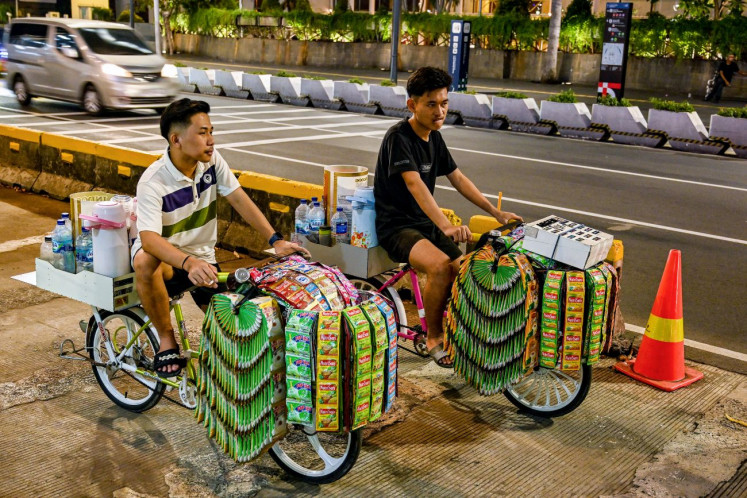Popular Reads
Top Results
Can't find what you're looking for?
View all search resultsPopular Reads
Top Results
Can't find what you're looking for?
View all search resultsBelt and Road Summit to focus on ASEAN infrastructure opportunities
The Hong Kong government, which will host the first Belt and Road Summit on May 18, chose infrastructure development opportunities in the Southeast Asian region as the main focus of discussions between business leaders, ministers and investors from around the world.
Change text size
Gift Premium Articles
to Anyone
 China's National Development and Reform Commission Chairman Xu Shaoshi (left) talks with Organization for Economic Cooperation and Development Secretary-General Angel Gurria before the start of a panel discussion during the China Development Forum at the Diaoyutai State Guesthouse in Beijing, March 20. (AP/Mark Schiefelbein)
China's National Development and Reform Commission Chairman Xu Shaoshi (left) talks with Organization for Economic Cooperation and Development Secretary-General Angel Gurria before the start of a panel discussion during the China Development Forum at the Diaoyutai State Guesthouse in Beijing, March 20. (AP/Mark Schiefelbein)
C
hina’s One Belt One Road (OBOR) development agenda to boost connectivity between mainland China and 65 countries in Asia and Europe by building infrastructure ties fits well with the 2010 Master Plan on ASEAN Connectivity.
The Hong Kong government, which will host the first Belt and Road Summit on May 18, chose infrastructure development opportunities in the Southeast Asian region as the main focus of discussions between business leaders, ministers and investors from around the world.
ASEAN countries will be able to tap the more than US$200 billion in financing resources that China’s policy banks, including the $100 billion Asian Infrastructure Investment Bank (AIIB) and the $50 billion Silk Road Infrastructure Fund, have committed to infrastructure, notably road and rail links and power grids along the corridor covered by the OBOR initiative.
President Xi Jinping launched the OBOR initiative in early 2014 to build a network of overland road and rail routes, oil and natural gas pipelines and other infrastructure that will stretch from central China through Central Asia and ultimately reach as far as Moscow and Venice.
But even though President Xi has asserted from the outset that the OBOR initiative would adhere to the principles of noninterference in other nations, not seeking to increase the sphere of influence, a number of countries are concerned over the geopolitical impact of the agenda.
Analysts, senior government officials and business leaders who talked to journalists from ASEAN countries during a series of presummit briefings in Hong Kong last week have mixed views on the OBOR initiative. The leading thread of views sees the initiative as the Chinese government’s recognition that its own prospects are inextricably linked with those of its trading partners along the OBOR route.
But if the controversies over several infrastructure projects China’s policy banks plan to finance in Indonesia, Thailand and Laos are any guide, the strongest note of caution prevailing now is: China needs to tread very carefully and work hard to gain trust for the Belt and Road agenda to boost connectivity and commerce between China and the 65 other countries involved.
A proposed $5 billion railway line that stretches through to Thailand could support that country’s ambitions to become a regional logistics hub, and China’s need to access key export markets, offering a win-win for both countries. But latest reports from Thailand suggest Thailand might go alone in financing the construction of the first phase of the project instead of seeking financial loans from China, as originally planned, due to what it claimed were unusually high interest rates charged by Chinese lenders.
The 250-kilometer railway is seen as part of an ambitious network linking Bangkok with Kunming in Southwest China’s Yunnan province, through Laos in the north and connecting Thailand, Malaysia and Singapore in the south.
Obviously, upon completion, the countries involved will all benefit from such regional arteries. But the uncertainty shows that different countries may have different expectations when they respond to China’s overtures.
Some prospective projects also could potentially be viewed as primarily benefiting China by building local infrastructure unrelated to the OBOR route, such as the $5 billion Jakarta-Bandung high-speed railway.
Such a suspicion may arise because the OBOR initiative was launched at a time when China’s economic growth fell from a two-digit level to below 7 percent.
Hence, many see the agenda as China’s attempt to export its huge excess manufacturing capacity in steel, cement and various other industrial products.
Such an impression has been strengthened by the fact that China’s policy bank loans extended for infrastructure development have mostly been tied to the involvement of Chinese companies, either as suppliers of machinery and raw materials or in construction and operation.
Hong-Kong based brokerage CLSA and China’s Citic Securities noted in a recent report that China was preparing to counter the accelerating slowdown in its domestic economy through enormous investments in overseas infrastructure that could absorb overcapacity in key industries.
The aggressive lending by China’s policy banks like the China Development Bank and Exim Bank to such developing countries as Indonesia has also been seen as a program to boost exports through Chinese companies that win construction jobs.
Last August, for example, the China Development Bank gave $3 billion in loans to Indonesian state-owned Bank Mandiri, BRI and BNI to finance infrastructure projects that involve Chinese construction companies. So suspicious has the House of Representatives been of these loans that the House’s finance commission summoned the directors of the three banks for explanations on how those loans were spent.
In addition, as Julian Vella, the Asia Pacific head of global infrastructure at KPMG International, cautioned in a recent analysis that Chinese investors must acknowledge that some of the countries on the proposed OBOR route have traditionally strong links to other nations with a vested interest in the region, and may resist China’s overtures.
Certainly, implementing the Belt and Road agenda will require a high level of mutual understanding of the regulatory, political, legal, financial and project risks, such as resource nationalism, transparency and labor unrest associated with potential projects along the OBOR route.
All in all though, seeing it from the positive side of things, the OBOR initiative will help fulfill part of Asia’s huge funding gap for infrastructure financing, which is estimated by the Asian Development Bank (ADB) at $800 billion annually over the next decade.
In fact Japan’s recent decision to commit more than $100 billion in new lending resources to the ADB within the next five years specially for funding high-quality infrastructure should also be seen as another positive impact of China’s OBOR initiative.
Yet more encouraging is the statement made by AIIB president Jin Liqun in Washington last Wednesday that the AIIB, the ADB and the World Bank would cofinance infrastructure projects in Asia.
***
The writer is senior editor at The Jakarta Post.
---------------
We are looking for information, opinions, and in-depth analysis from experts or scholars in a variety of fields. We choose articles based on facts or opinions about general news, as well as quality analysis and commentary about Indonesia or international events. Send your piece to community@jakpost.com.









